





 |
 |
 |
 |
 |
 |
|---|---|---|---|---|---|
 |
 |
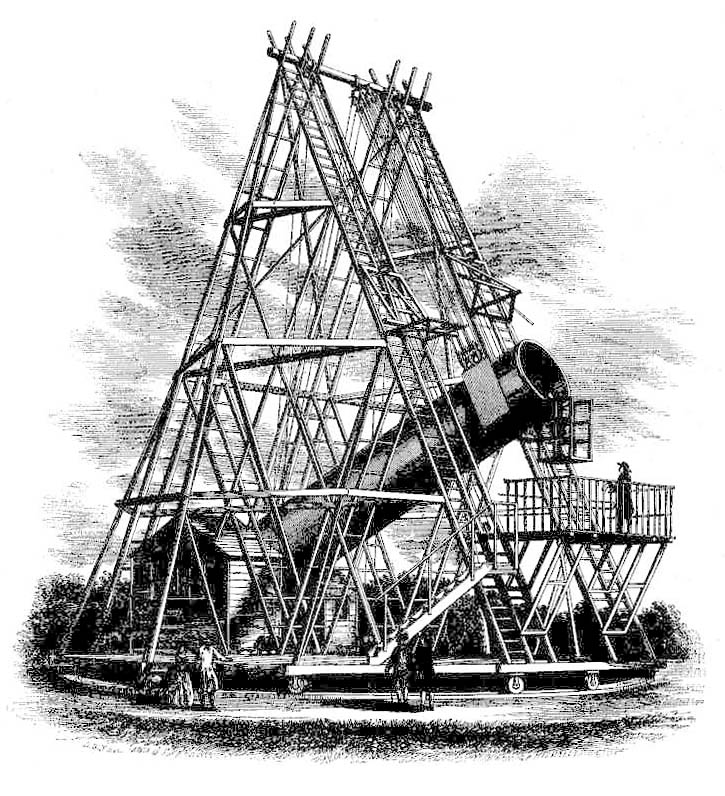 |
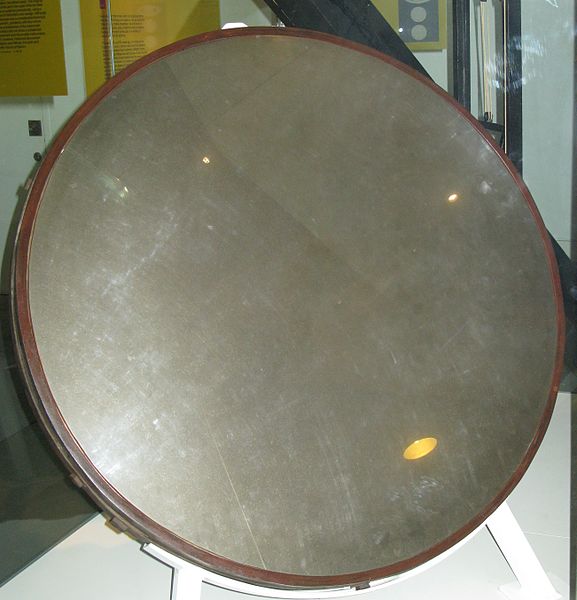 |
 |
|---|---|---|---|---|
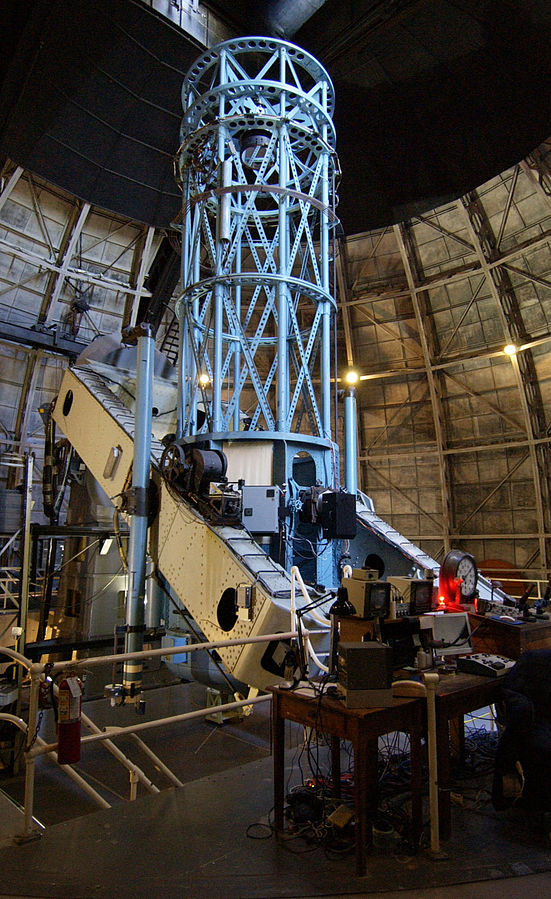 |
.jpg) |
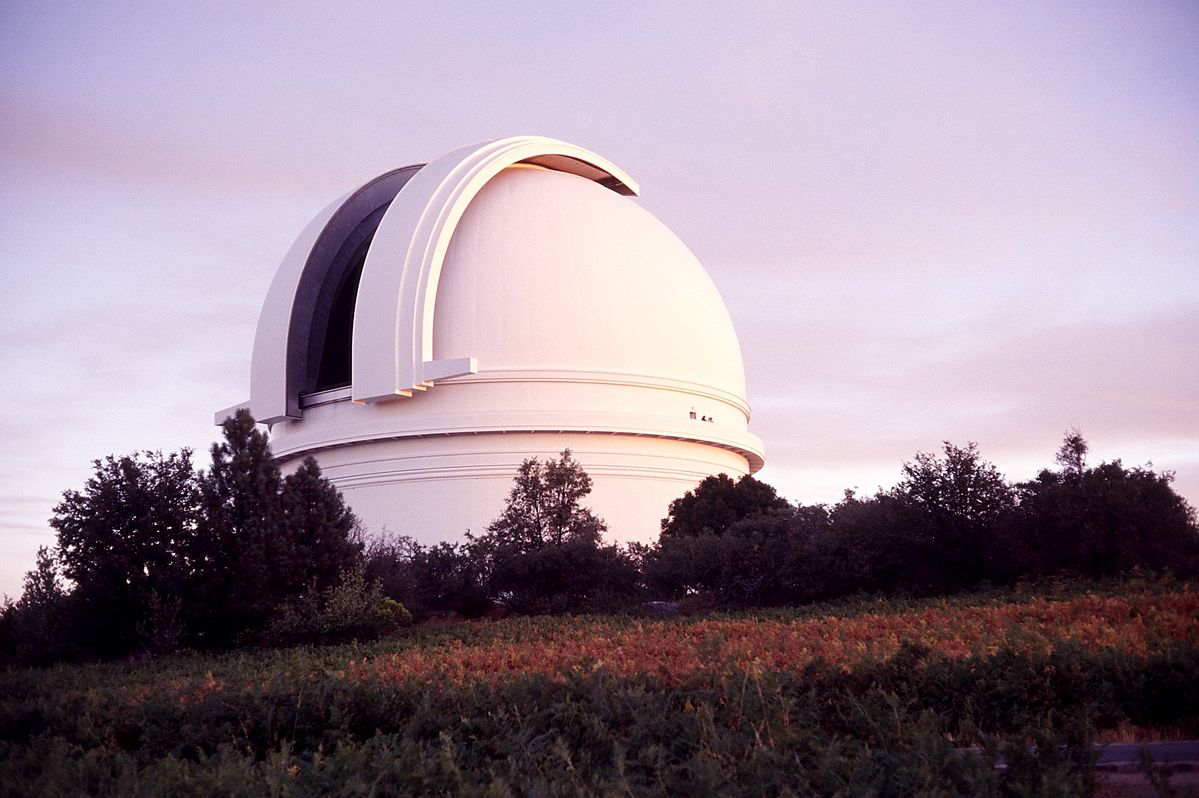 |
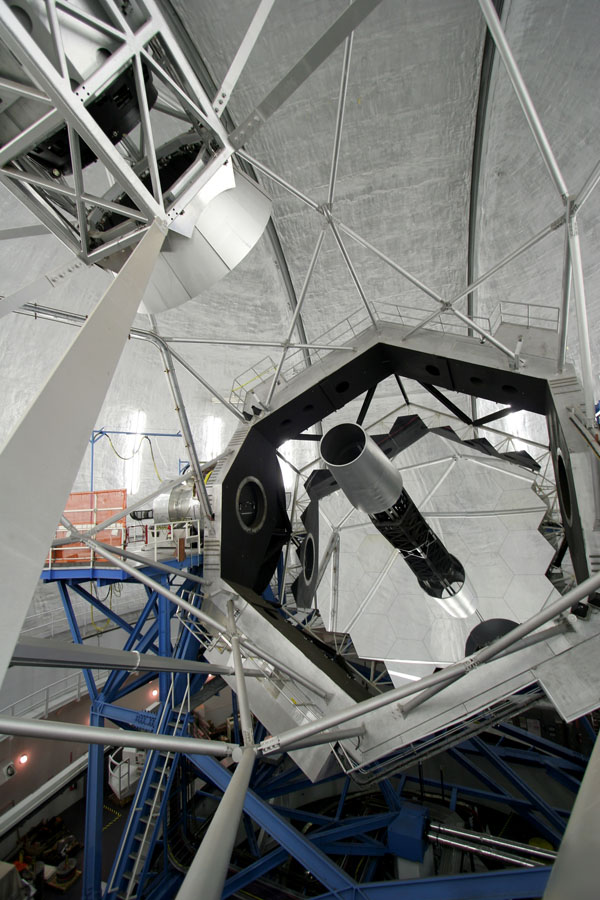 |
|
|---|---|---|---|---|
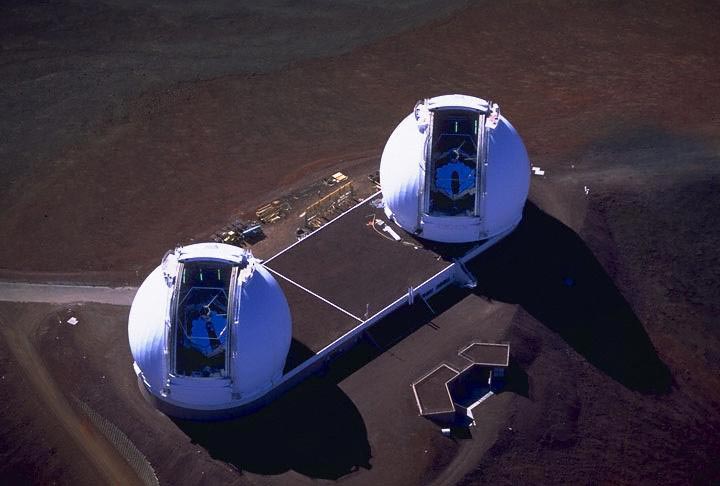 |
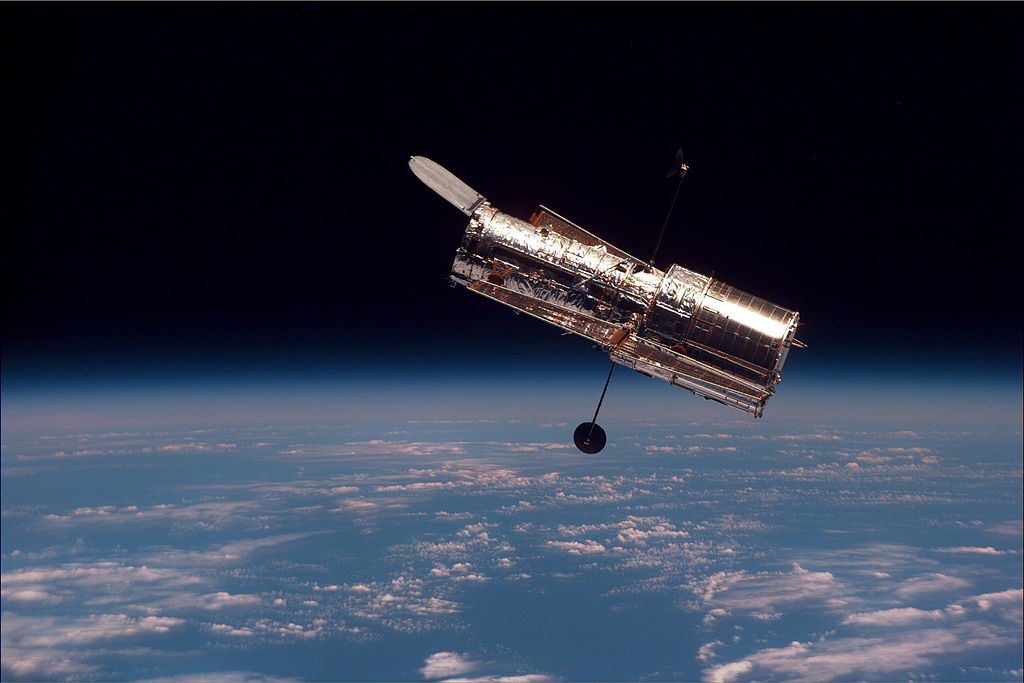 |
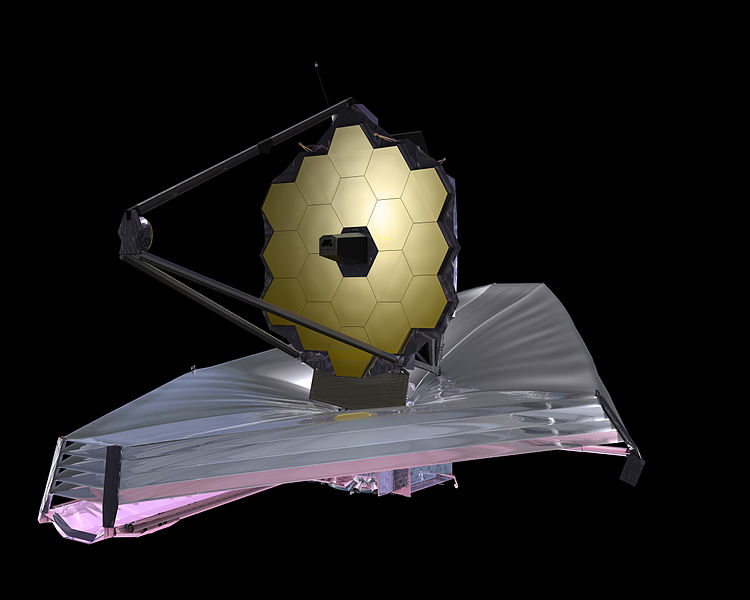 |
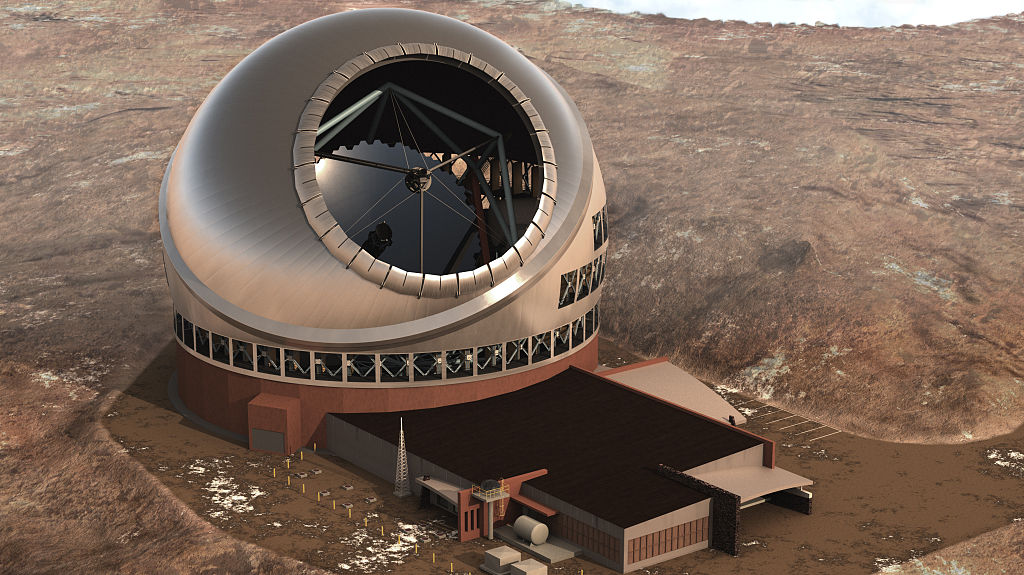 |
|---|---|---|---|
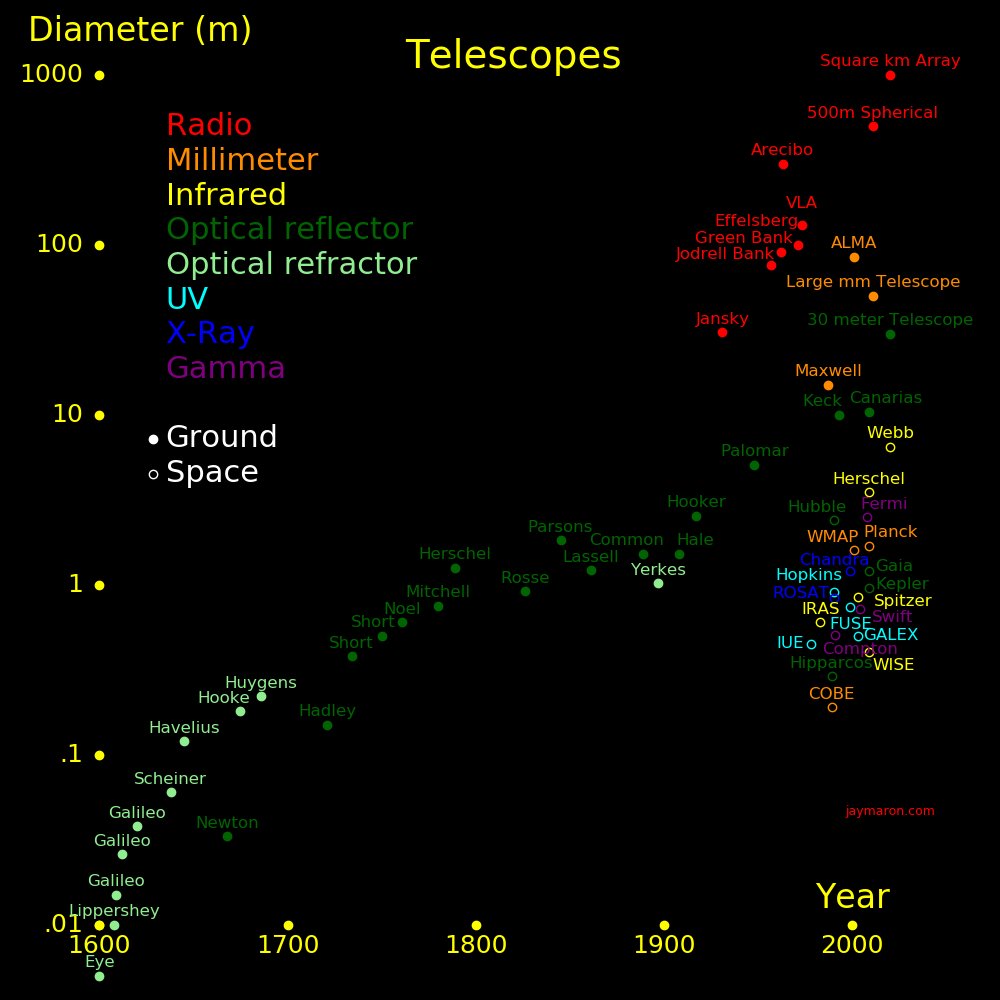 |
|---|
Telescope Diameter Resolution Year
(meters) (arcsecond)
Human eye .005 60
Lippershey's telescope ? ? 1608 First telescope. Refractor
Galileo's telescope #1 .015 7 1609 Refractor
Galileo's telescope #3 .038 2.1 1620 Refractor
Newton's telescope .033 2.5 1668 First reflecting telescope
10 cm telescope .1 .5 Seeing limit
Herschel telescope 1.20 .5 1789 Reflector
Yerkes refractor 1.02 .5 1897 Refractor. End of refractor age
Hale 60-inch 1.52 .5 1908 Mount Wilson observatory
Hooker 100-inch 2.54 .5 1917 Mount Wilson observatory
Hale 200-inch 5.08 .5 1948 Palomar Observatory
Keck 10 .04 1993 Mauna Kea Observatory
Hubble 2.4 .04 1990 Space. Earth orbit
Webb Space Telescope 6.5 .02 2022 Space. L2 Lagrange point
Thirty Meter Telescope 30 .015 ? Mauna Kea Observatory
Extremely Large Tele. 39.3 .005 ? Chile
Modern ground telescopes have adaptive optics to transcend the seeing limit.
 |
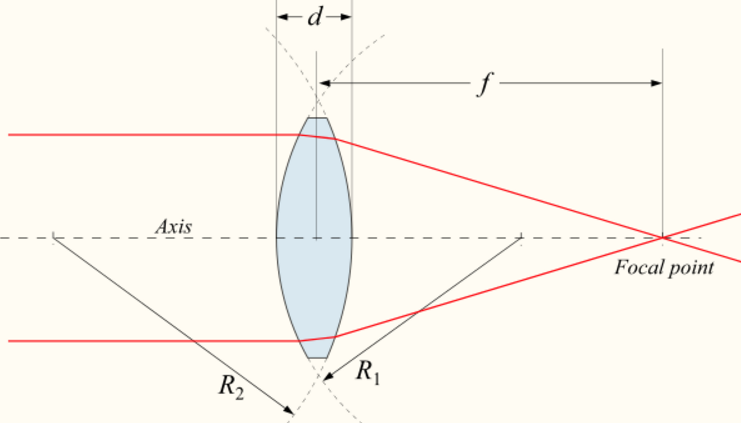 |
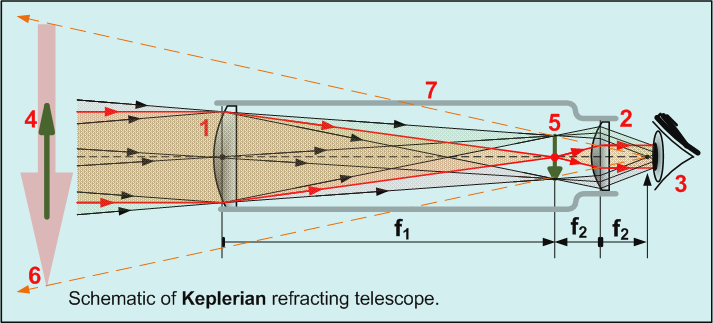 |
|---|---|---|
Refraction depends on wavelength, which introduces "chromatic aberration". This limits the size of refracting telescopes. Reflecting telescopes don't suffer this limitation.
 |
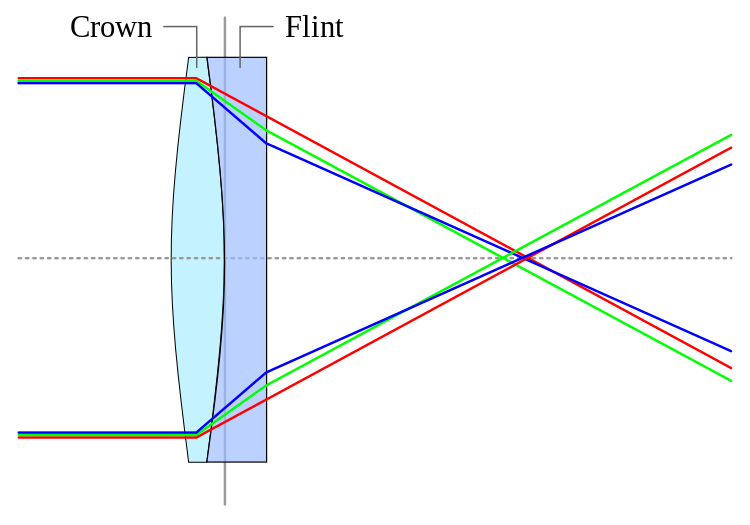 |
|---|---|
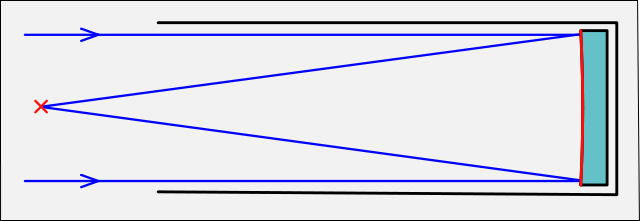 |
 |
 |
|---|---|---|
 |
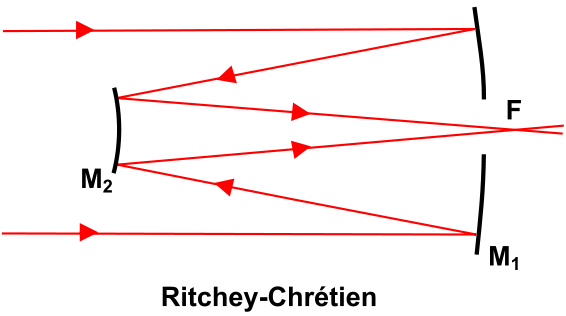 |
|---|---|
1608 Lippershey constructs the first refracting telescope 1663 Gregory publishes a design for a "Gregorian" reflector 1668 Newton constructs the first reflecting telescope, a "Newtonian" reflector 1672 Cassegrain publishes a design for a "Cassegrain" reflector 1910 Ritchey-Chretien reflecting telescope, the basis for modern reflectors
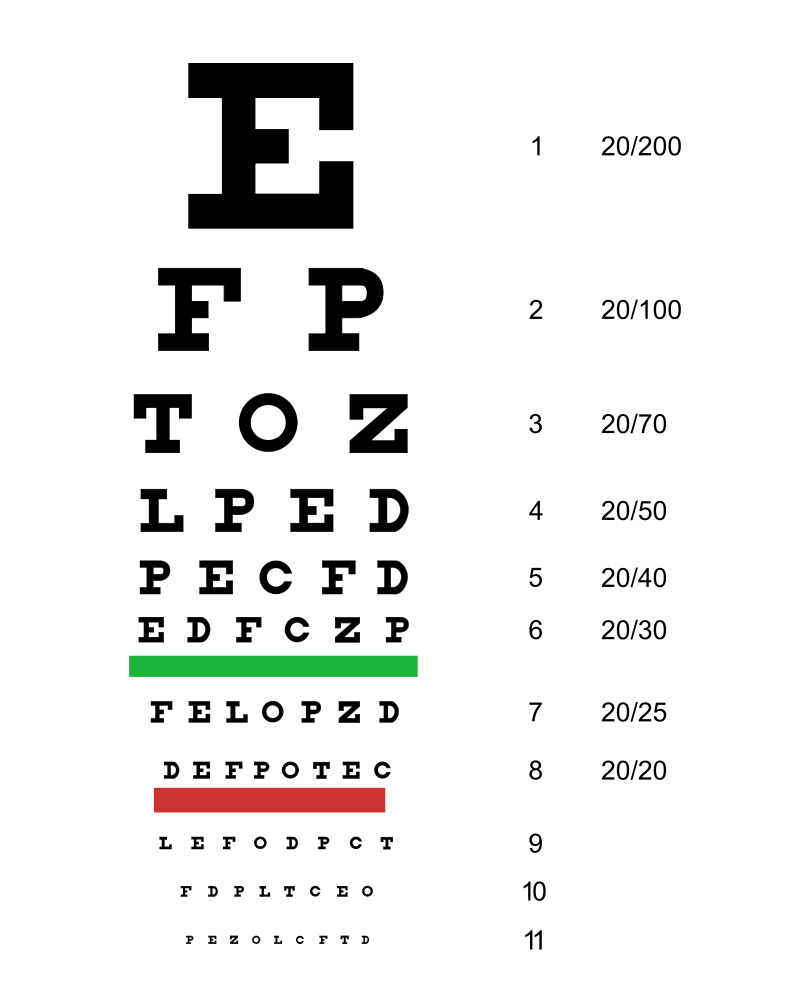 |
|---|
A person with 20/20 vision can distinguish parallel lines that are spaced by an angle of .0003 radians, about 3 times the diffraction limit. Text can be resolved down to an angle of .0015 radians.
Resolution Resolution Diopters
for parallel for letters (meters-1)
lines (radians)
(radians)
20/20 .0003 .0015 0
20/40 .0006 .0030 -1
20/80 .0012 .0060 -2
20/150 .0022 .011 -3
20/300 .0045 .025 -4
20/400 .0060 .030 -5
20/500 .0075 .038 -6
"Diopters" is a measure of the lens strength required to correct vision to 20/20.
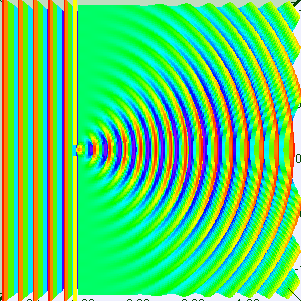 |
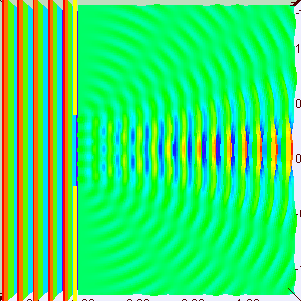 |
|---|---|
The resolution of a telescope is limited by diffraction.
Wavelength of light = L Mirror diameter = D Resolution angle = θ = 1.22 * L / DIf we assume blue light with L=440 nm,
D θ
Eye .005 .00011
10 cm telescope .1 .0000054
Hubble telescope 2.5 .00000021
1 Degree = 60 arcminutes = 3600 arcseconds
1 arcsecond = 4.8e-6 radians
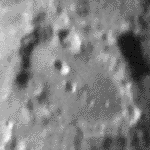 |
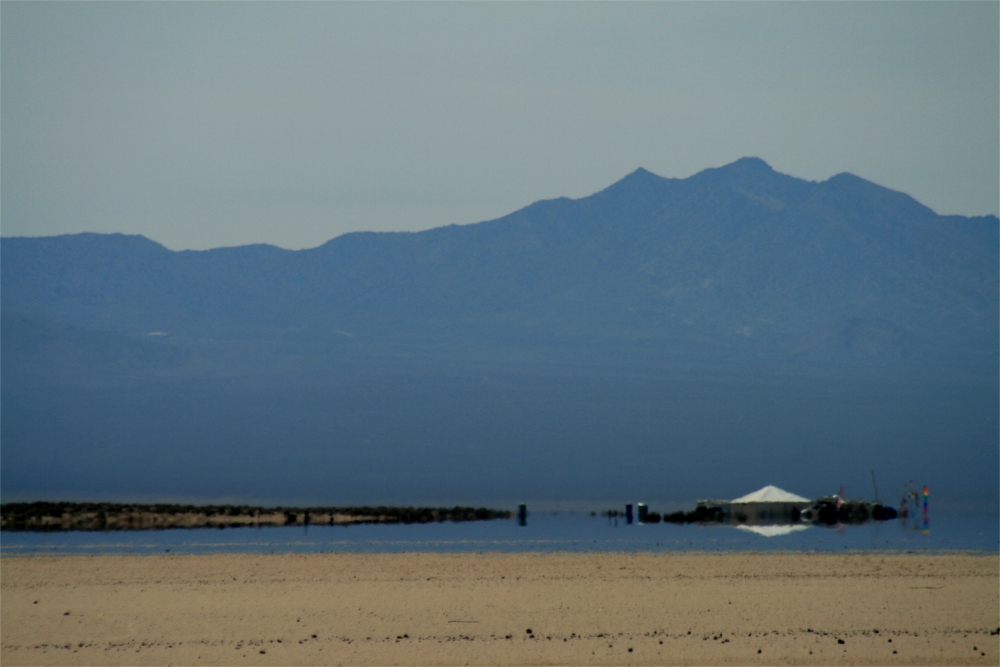 |
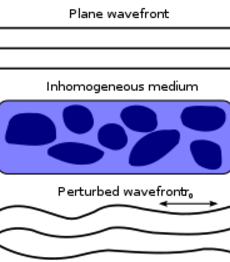 |
|---|---|---|
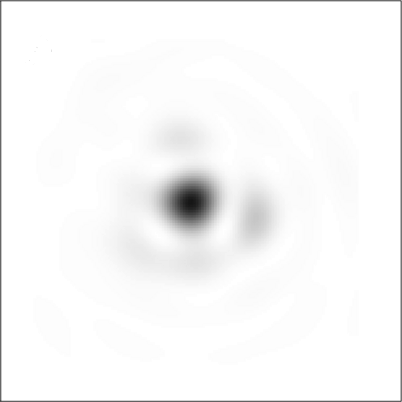 |
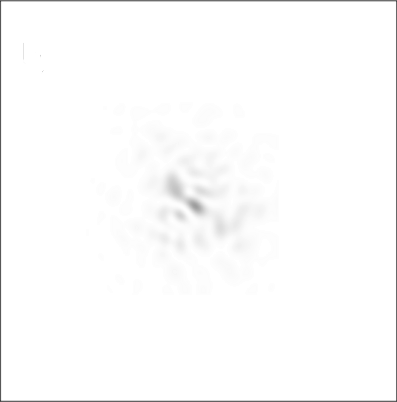 |
|---|---|
The atmosphere blurs light from outer space, limiting telescopes to a resolution of 5e-6 radians or 1 arcsecond. This is the resolution of a 10 cm telescope. A telescope larger than 10 cm has the same resolution as a 10 cm telescope. The advantage of the larger telescope is more light.
Telescope Resolution Reason for diameter (radians) resolution limit (meters) < .1 5e-7 / Diameter Diffraction > .1 5e-6 AtmosphereA space telescope doesn't experience atmospheric distoration and the limit is from diffraction only. The 2.5 meter Hubble space telescope has a better resolution than the 10 meter Keck Earth telescope.
Telescopes equipped with "adaptive optics" can correct atmospheric distortion and reach a resolution better than 5e-6 radians.
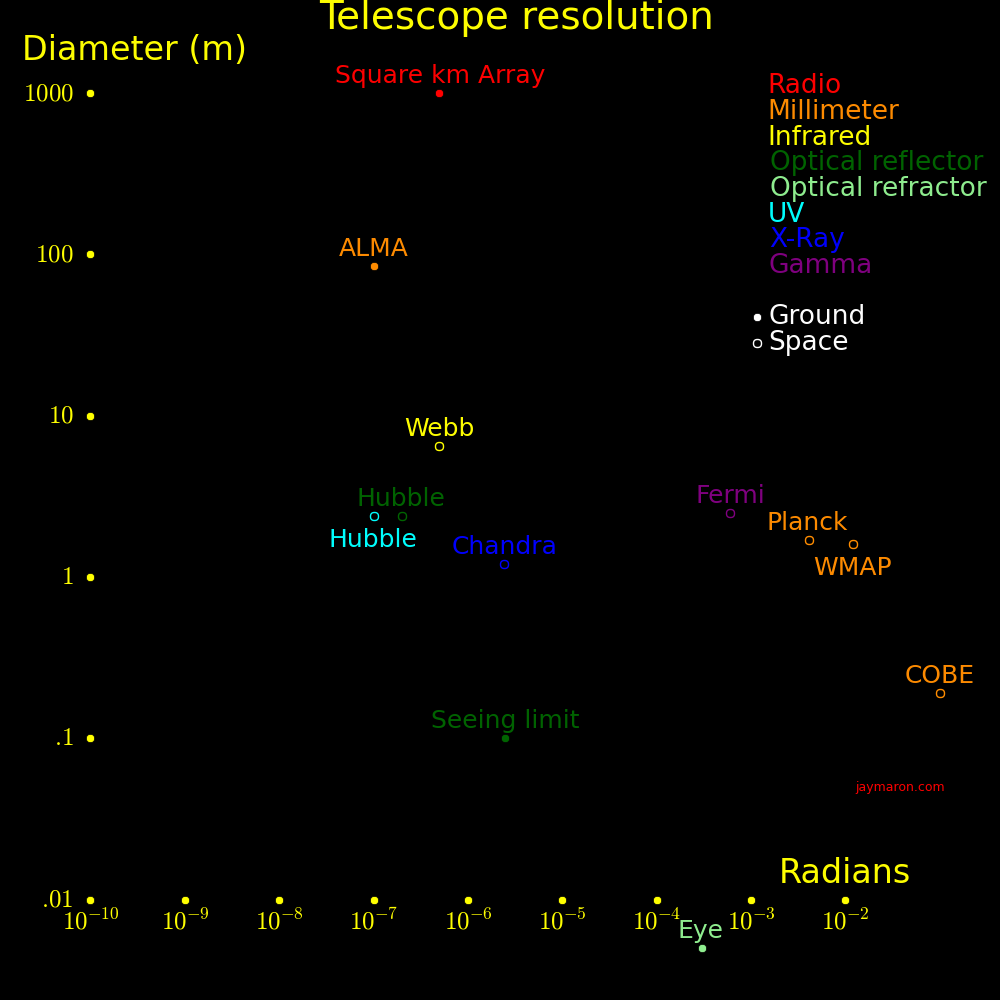 |
|---|
Astronomers measure brightness in a goofy unit called "magnitudes". It was defined by Hipparcos in Ancient Greece and it's still with us.
The "Apparent luminosity" of a star is its brightness as viewed from the Earth.
The "Absolute luminosity" is the power generated by a star in Watts.
Distance to star = R meters Luminosity = L = 3.29⋅1028 * 10-M/2.5 Watts Flux = l = L / (4 π R2) Watts/meter2 Absolute magnitude = M = m + 87.71 - 2.17 log10(R) Apparent magnitude = m = M - 87.71 + 2.17 log10(R) Flux corresponds to the brightness of an object as viewed from the Earth.The fainter an object, the larger its apparent magnitude "m".
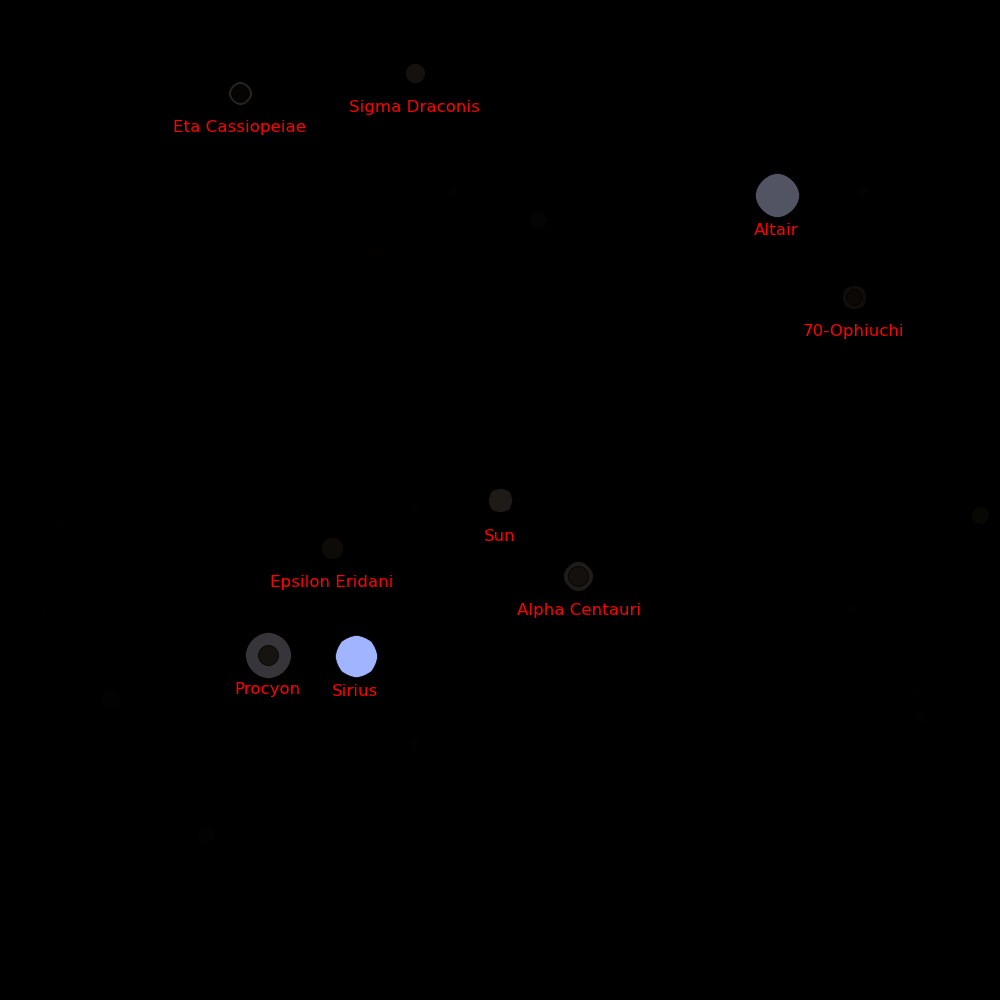 |
|---|
Distance Luminosity Flux Absolute Apparent
from Watts Watts/m2 magnitude magnitude
Earth (L) (l) (M) (m)
Sun 1 AU 3.8e26 1360 4.8 -26.7
Full Moon .00257 AU 4.8e15 2.6e-3 32.1 -12.7
Mars .52 AU 2.3e16 3.1e-7 30.4 -2.9
Jupiter 4.2 AU 1.5e18 3.1e-7 25.8 -2.9
Saturn 8.5 AU 6.8e17 3.4e-8 26.7 -.5
Uranus 18.2 AU 1.5e16 1.6e-10 30.9 5.3 Discovered 1781
Ceres 1.77 AU 4.3e13 4.9e-11 37.2 6.6 Discovered 1801
Neptune 29.1 AU 3.8e15 1.6e-11 32.3 7.8 Discovered 1846
Pluto 28.7 AU 1.8e13 7.8e-14 38.2 13.6 Discovered 1930
Alpha Centauri A 4.36 ly 5.9e26 2.7e-8 4.4 0.0
WISE-0855 7.2 ly 3.4e21 5.9e-14 17.5 13.9 Rogue planet
Sirius 8.58 ly 9.8e27 1.2e-7 1.4 -1.5 Brightest star
Exo-Sun 10.0 ly 3.8e26 3.4e-9 4.8 2.0
Exo-Earth 10.0 ly 5.4e16 4.8e-19 29.5 26.6
Betelgeuse 640 ly 5.8e31 1.3e-7 -6.0 .4 Massive star
Andromeda 2560000 ly 9.9e36 1.3e-9 -21.6 4.2
Values for solar system objects are for when they are closest to the Earth.
Uranus is at the limit of human vision. It's conceivable that an ancient civilization could have detected Uranus. Ceres is just beyond human vision.
WISE-0855 is a brown dwarf with a mass somewhere between 3 and 10 Jupiter masses. It has a temperature of 240 Kelvin and was detected by the WISE infrared space telescope.
"Exo-Sun" and "Exo-Earth" are values for if the sun and the Earth are at a distance of 10 light years.
GRB 080319B is the most luminous recorded gamma ray burst.
 |
|---|
The horizontal lines represent the limits of the Pan-STARRS, Keck, Hubble, and Webb telescopes. Exo-Earth is detectable by the Keck telescope.
Flux Apparent
limit magnitude
Watts/m2 limit
Human eye 3.4e-11 7
Pan-STARRS 5e-18 24
Keck 10 meter 1e-19 28
Hubble 1e-20 31
Webb 5e-22 34
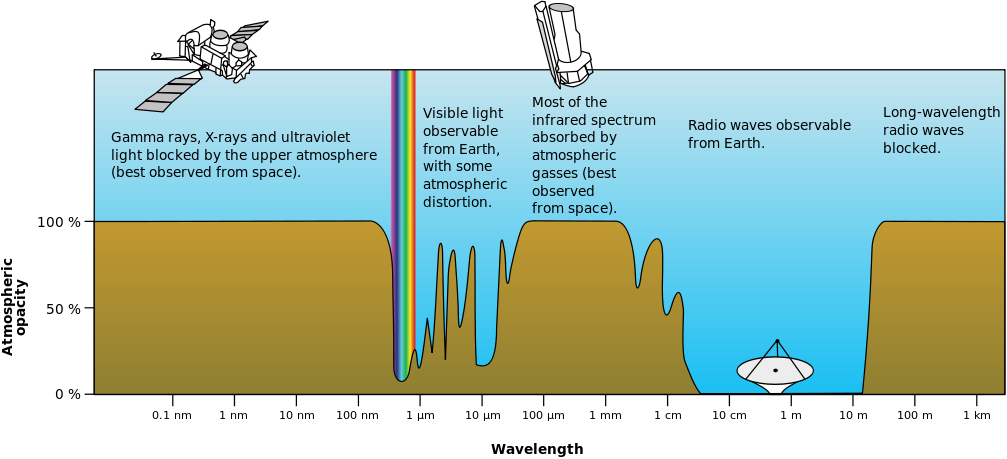 |
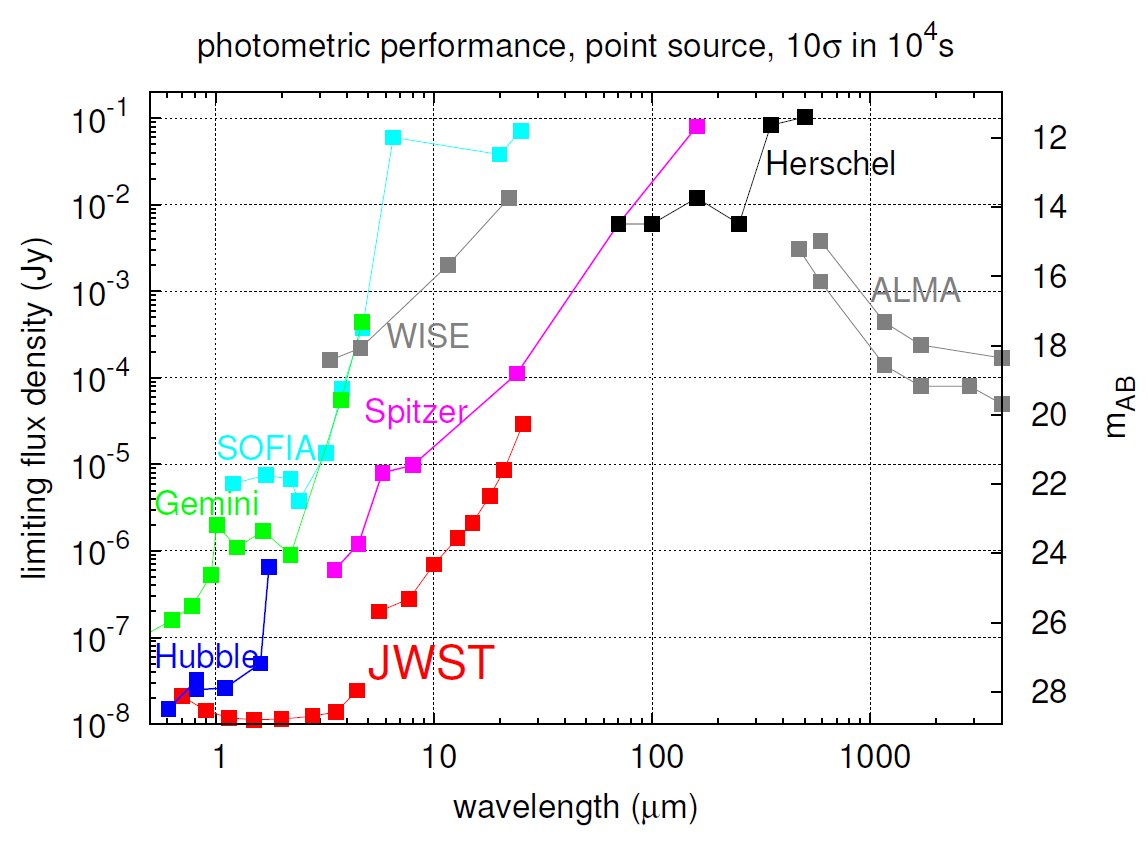 |
|---|---|
Observable from the ground?
Gamma ray No
X ray No
Ultraviolet No
Visible Yes
Infrared No
Millimeter Yes, if the air is dry
Radio Yes
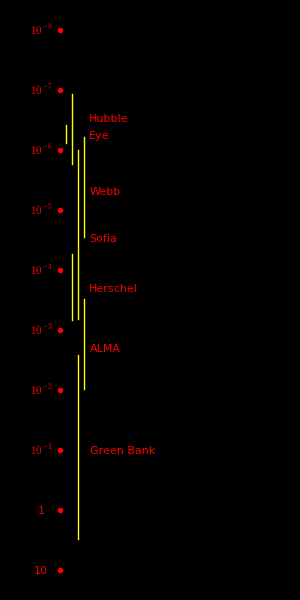 |
|---|
The SOFIA tel escope can see in the infrared because it flies on a Boeing 747 at an altutude of 12 km, which is above most of the atmosphere's water.
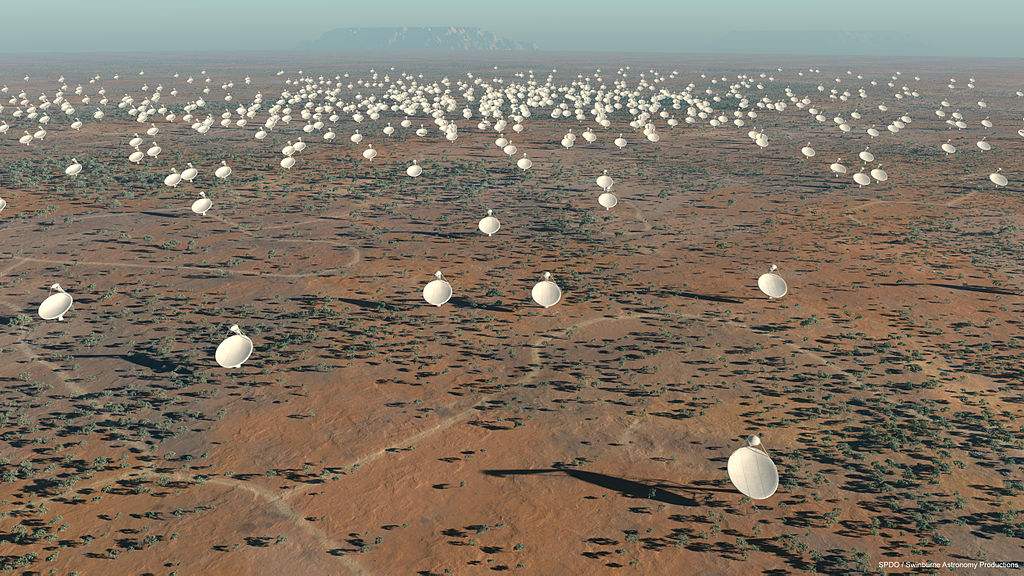 |
 |
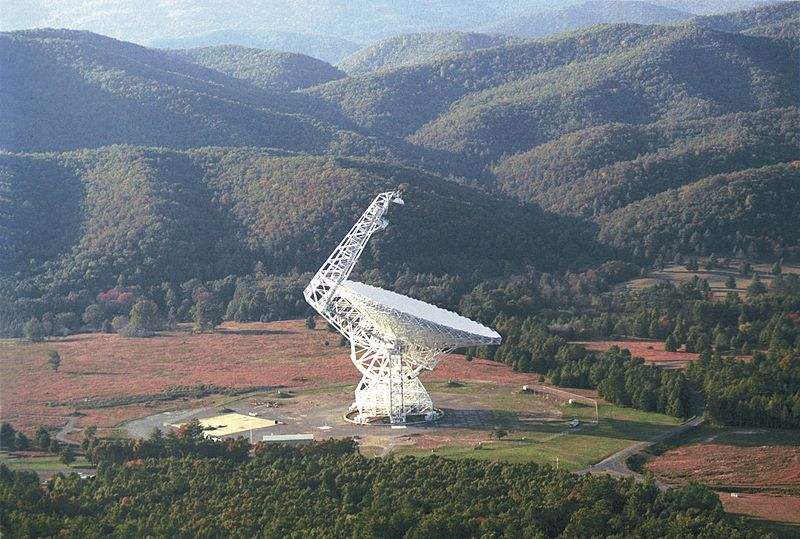 |
|---|---|---|
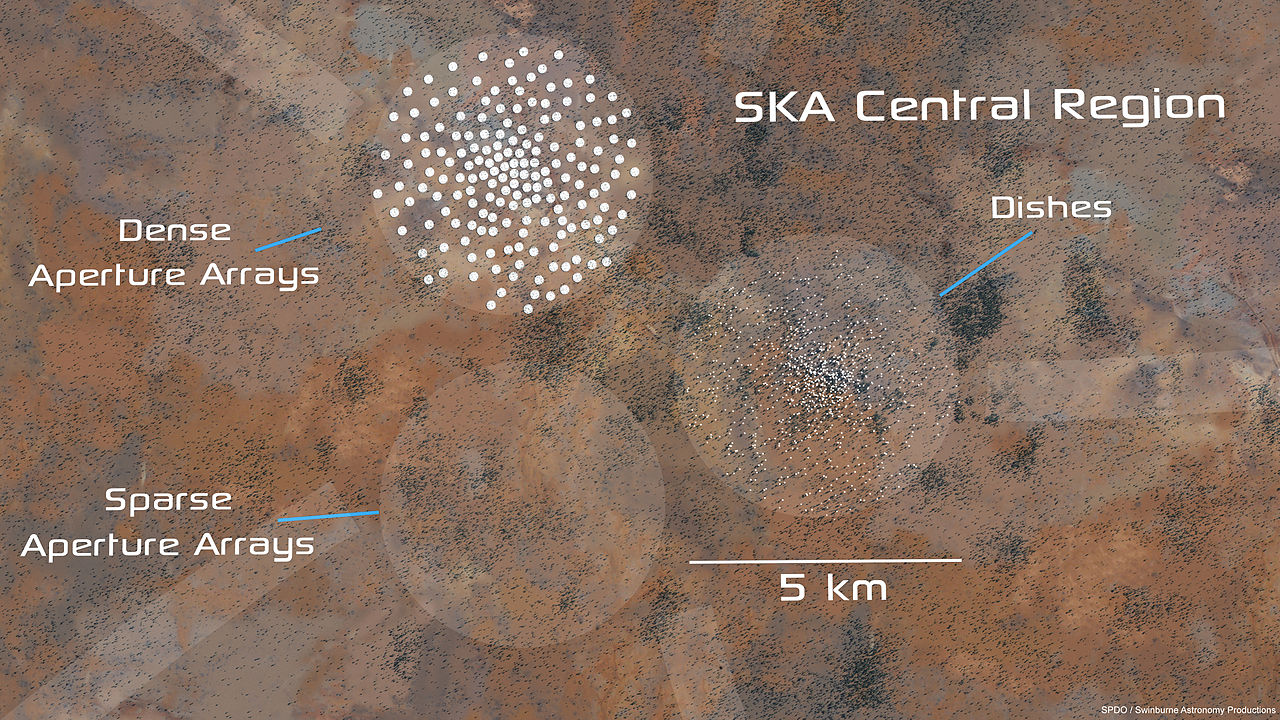 |
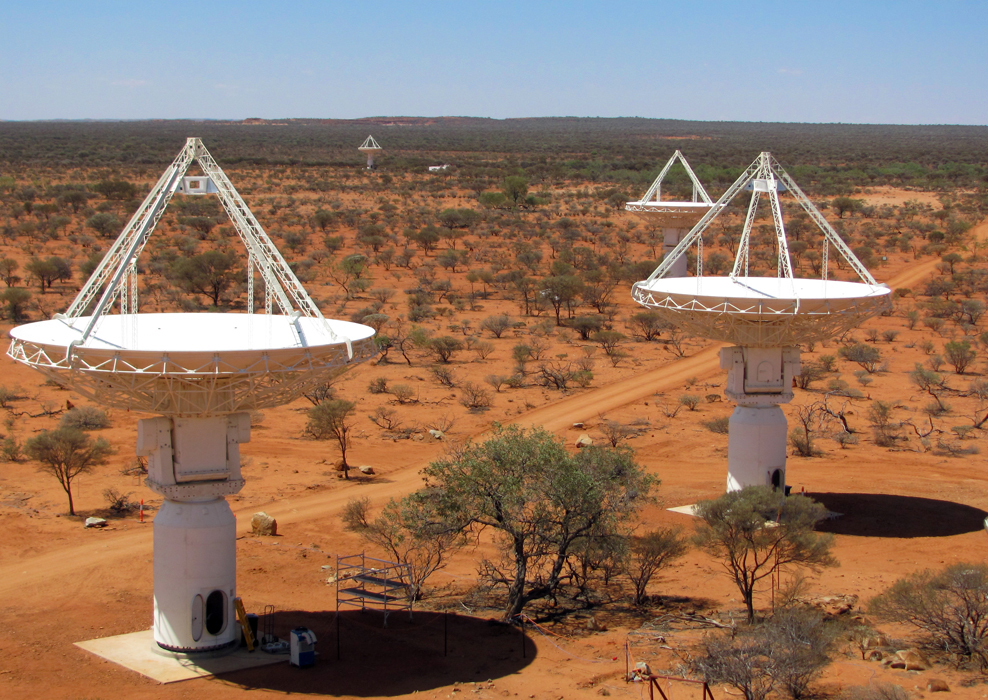 |
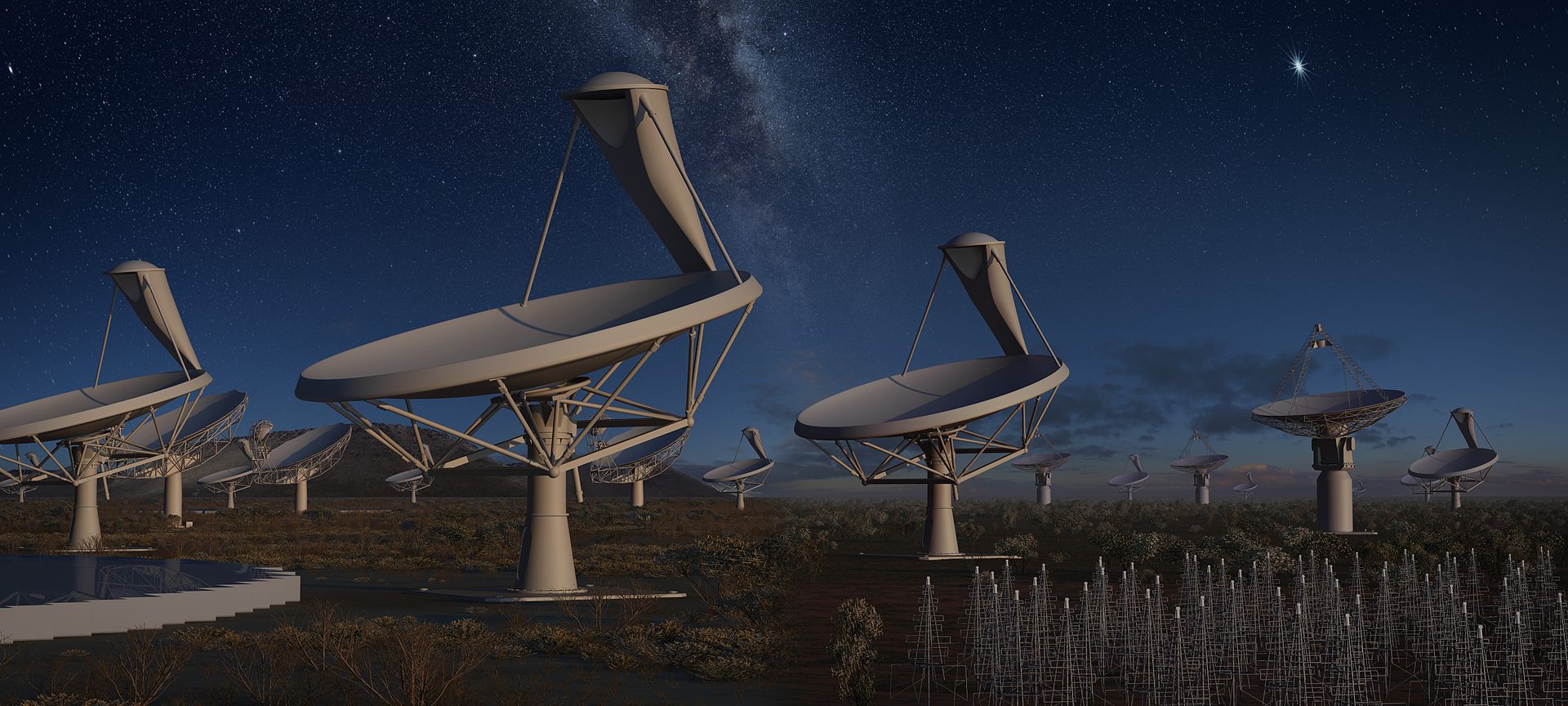 |
|---|---|---|
Min & Max
Aperture Year wavelength
(m) (meters)
Square kilometer Array 1000 2019 .01 4.3 Australia and South Africa
Green Bank II 100 2000 .0026 3.0 Green Bank, West Virginia. Largest steerable dish
Arecibo 300 1963 .03 1.0 Puerto Rico
Green Bank I 91 1962 Collapsed and rebuilt as Green Bank II
Jodrell Bank 76 1951
Jansky 30 1931
Astron 10 2011 .01 1.0 High Earth orbit. Used for large-baseline interferometry
Min & Max
Aperture Year wavelength
(meters) (mm)
CSO 10.5 1986 .3 2.0 Mauna Kea Caltech
Maxwell 15 1987 .3 2.0 Mauna Kea
ALMA 12 2011 .3 9.6 Atacama Desert, Chile 54 12-meter dishes and 12 7-meter dishes
LMT 50 2011 .85 4.0 Sierra Negra, Mexico Large millimeter Telescope
CCAT 25 2017 Cerro Chajnantor, Chile Wavelength range similar to ALMA
CSO = Caltech submillimeter observatory
CCAT = Cerro Chajnantor Atacama Telescope
ALMA = Atacama Large Millimeter Array
Diameter Resolution Mass Min Max Year Location
(m) (urad) (tons) (mm) (mm)
Planck 1.9 4100 .21 .3 11 2009 L2
WMAP 1.6 12000 .76 .32 1.30 2001 L2
COBE .19 1.41 1989 Geocentric
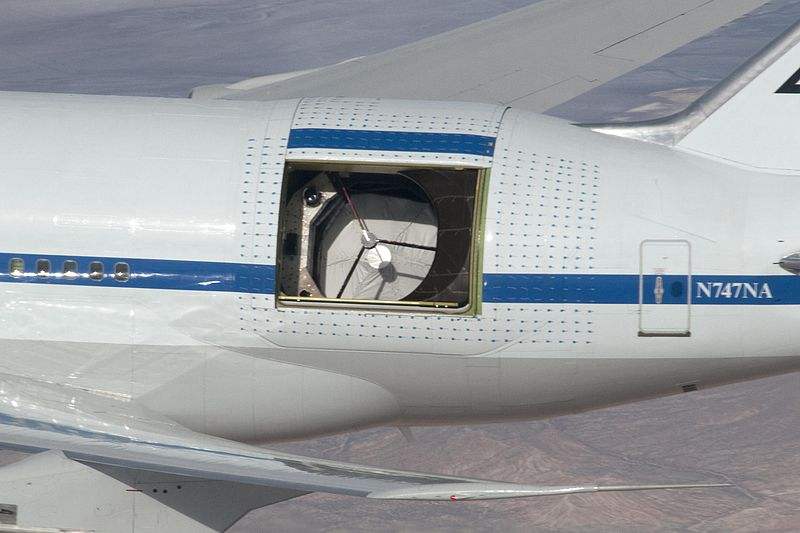 |
|---|
Aperture Year Min Max Location
(meters) (mm) (mm)
WMAP 1.6 2001 .003 .015 L2 Lagrange point NASA Observes cosmic microwave background
Spitzer .85 2003 .003 .180 Sun orbit NASA
WISE .40 2009 .003 .025 Earth orbit NASA
Herschel 3.5 2009 .055 .672 L2 ESA
SOFIA 2.5 2010 .001 .655 Boeing 747 at an altitude of 12 km
SOFIA = Stratospheric Observatory for Infrared Astronomy
Aperture Low High
meter nm nm
International UV Explorer .45 115 320 1978 1996 Full-spectrum reflector
FUSE 90 120 1999 2007 Full-spectrum reflector
Extreme UV Imaging Telescope 17 30 Monochromatic reflectors at 4 wavelengths
EUEV 7 76 1992 2001 Grazing incidence
Rosat XUV .84 .6 30 1990 1999 Grazing incidence
Aperture Resolution Low High Focus Mass Year
meter urad keV keV m tons
Rosat .84 .1 2 1990
Swift .30 .2 10 .61 2004 Geocentric NASA GSFC
Chandra 1.2 2.4 .1 10 10 4.8 1999 Geocentric NASA SAO CXC
XMM-Newton .70 24 .1 12 7.5 3.2 1999 Geocentric ESA
Hitomi soft .3 12 5.6 2.7 2016 Geocentric JAXA
Hitomi hard 5 80 12 2.7 2016 Geocentric JAXA
NuSTAR .32 46 3 79 10.15 .17 2012 Geocentric NASA
INTEGRAL JEM-X .31 3 35 4.0 2002 Geocentric ESA RKA NASA
INTEGRAL Main .31 3500 15 10000 4.0 2002 Geocentric ESA RKA NASA
NuSTAR has a collecting area of 847 cm2 at 7 keV and a collecting area of 60 cm2 at 78 keV. The field of view is 12 arcminutes.
The Hitomi lost attitude control and went into an uncontrollable spin, destroying the telescope.
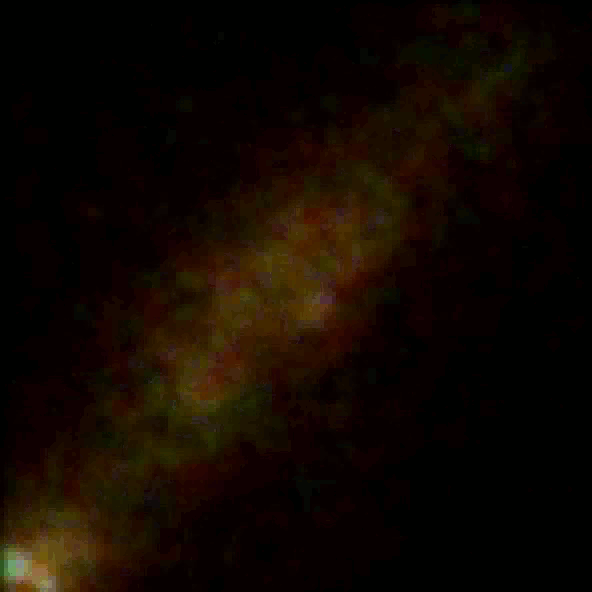 |
|---|
Year Low High Mass
MeV MeV tons
Hitomi 2016 .06 .6 2.7 Geocentric JAXA
INTEGRAL 2002 .015 10 4.0 Geocentric ESA RKA NASA
Fermi 2008 30 300000 4.3 Lagrange #2 NASA
Aperture Magnitude Field of Exposure Full-sky CCD Year
meters limit view seconds survey time Gpixels
degrees days
Pan-STARRS 3.6 24.0 3.0 60 8 1.4 2010 Hawaii
LSST 8.4 24.5 3.5 15 2 3.2 2021 El Penon, Chile
The Pan-STARRS and LSST telescopes are designed to find solar system objects, which is why they use short exposures.
Frequency = F
Wavelength = W
Planck constant = h = 4.1357⋅10-15 eV seconds
Speed of light = C = F W = 2.9979⋅108 meters/second
Energy = E = h F
Aperture diameter = D
Diffraction angle = A = 1.22 W / D
Energy Wavelength Temperature
(eV) (nm) (Kelvin)
Gamma ray 1000000 .0012
X-Ray 1000 1.2 290000
Bohr energy 13.6 91 32000
UV-Extreme min 12.4 100 29000
UV-C min 4.43 280 10350
UV-B min 3.94 315 9200
Human UV limit 3.10 400 7244
Violet 3.06 405 7155
Blue 2.79 445 6512
Cyan 2.58 480 6037
Green 2.33 532 5447
Yellow 2.10 589 4920
Orange 2.03 610 4750
Red 1.91 650 4458
Human IR limit 1.63 750 3864
1 electron Volt 1 1222 2371
Infrared .12 10000 290
Millimeter .0012 106 2.90 300 GHz
Radio 109 .0029 300 MHz
1800 Herschel discovers infrared light by its effect on a thermometer
1801 Ritter discovers UV rays by their effect on AgCl
1835 Melloni builds a thermoelectric infrared detector
1878 UV rays are found to kill bacteria
1879 Stefan-Boltzmann law: Power = Constant * Area * Temperature^4
1901 Planck hypothesizes that E=hF
1905 Einstein discovers the photoelectric effect
1960 UV rays found to be harmful to DNA
 |
 |
|---|---|
"Ridge A" in Antarctica is a 4 km high plateau where the environment is cold, dry, and has no wind, making it the best place in the world for a telescope. Resolution is up to 3 times higher than what can be achieved by telescopes at the equator. It is also ideal for submillimeter astronomy, which requires cold dry air.
Properties of Ridge A:
Altitude = 4053 meters.
Distance from the South Pole = 1000 km.
Distance from Dome A = 144 km. Dome A is the highest ice feature in
Antarctica, with an altitude of 4091 meters.
Annual snowfall = 2 cm.
Average temperature = -70 Celsius.
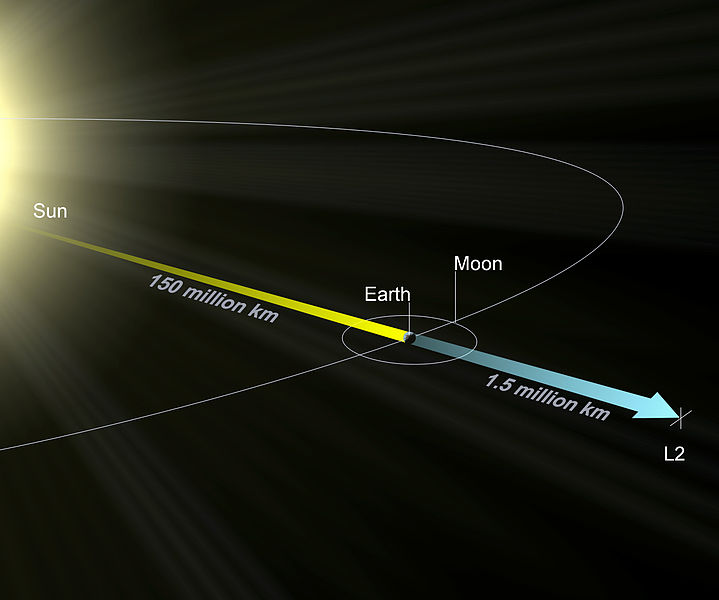 |
 |
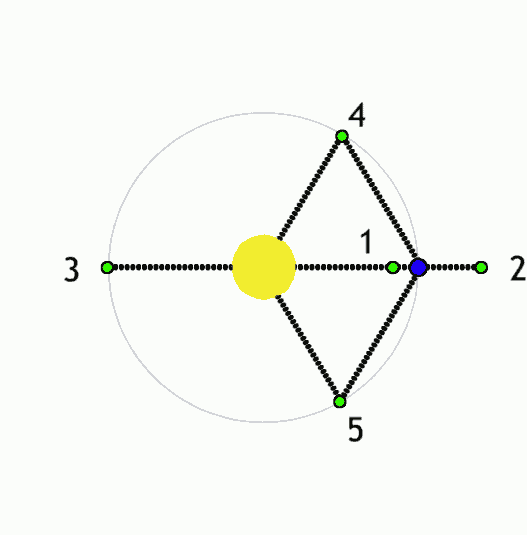 |
 |
|---|---|---|---|
The Lagrange L2 point orbits the sun synchronously with the Earth. It's the best place for space telescopes because it's possible there to simultaneously block out light from the sun, moon, and Earth. The Webb telescope will be sent to L2 when completed.
Existing space telescopes suffer disadvantages because they're not manned. They have to function automously, they have to be prebuilt on the Earth, and they have to be sturdy enough to survive the launch into space.
If you have a manned space station these problems don't exist. Telescopes can be built on site from prefabricated modules. For example, small mirror segments can built on Earth, launched into space, and assembled to form a large mirror. Assembling mirror segments is easy in space because of the zero gravity. A manned space station also makes it possible to operate and repair the telescope on site.
The largest space telescopes are:
Diameter Wavelength Location Mass
meters tons
Spektr-R 10 Radio Geocentric 2.5
Planck 1.9 Millimeter L2 .21
Webb 6.5 Infrared L2 6.5
Hubble 2.4 Visible Low Earth orbit 11.1
Chandra 1.2 X-ray Geocentric 4.8
Fermi 1.8 Gamma ray L2 4.3
The only limit to the size of a space telescope is the amount of mass that can be launched from the Earth. Launching 1000 tons into space costs 2 billion dollars. We can expect that the new generation of space telescopes will have masses on the order of 1000 tons and diameters on the order of 100 meters.
 |
 |
|---|---|
"Ridge A" in Antarctica is a 4 km high plateau where the environment is cold, dry, and has no wind, making it the best place in the world for a telescope. Resolution is up to 3 times higher than what can be achieved by telescopes at the equator. It is also ideal for submillimeter astronomy, which requires cold dry air.
Properties of Ridge A:
Altitude = 4053 meters.
Distance from the South Pole = 1000 km.
Distance from Dome A = 144 km. Dome A is the highest ice feature in
Antarctica, with an altitude of 4091 meters.
Annual snowfall = 2 cm.
Average temperature = -70 Celsius.
 |
|---|
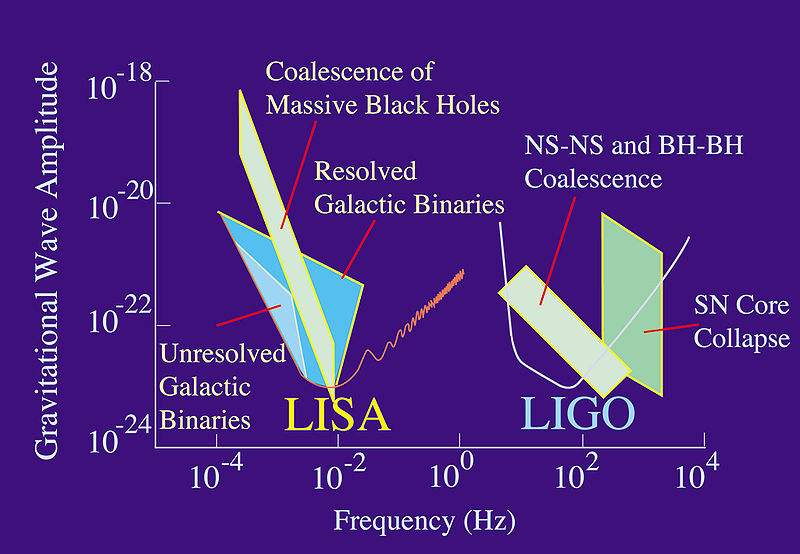 |
|---|
Gravity waves are detected by the LIGO detectors in Washington and Louisiana, the Virgo detector in Italy, and the GEO 600 detector in Germany. Thus far the following events have been observed (masses in solar masses):
Primary Secondary Merger Energy Distance
mass mass mass released (MParsec)
35.4 29.8 62.2 3.0 440
23 13 35 1.5 1000
14.2 7.5 20.8 1.0 440
31.2 19.4 48.7 2.0 880
30.5 25.3 53.2 2.7 540
1.48 1.26 2.74 <.025 40 Primary and secondary are neutron stars.
Unknown if the merger is a NS or black hole
The boundary between a neutron star and a black hole is around 3 solar masses.
LIGO is an Earth detector and LISA is a space detector. The frequency ranges are:
Year Range (Hertz)
LIGO 2002 300 - 7000 Washington
LISA ~2025 .00003 - 0.001 Sun orbit
Projects such as SETI, Kepler, LIGO, and Pan-STARRS require massive data and computation and are well suited to crowd computing.
TFlops
Folding@home 39700 Protein folding
GPUGRID.net 2570 Simulations of proteins
Milkyway@home 1175 Construct a 3D map of the Milky Way
Einstein@home 1138 Search for pulsars
Collatz conjecture 623
SETI@home 594 Search for alien radio signals
Asteroids@home 135
theSkyNet 46 Analyze data from the Square Kilometer Array
Neutrino Min Volume Source Year
type energy
(GeV)
Super-Kamiokande E M T .00005 S A G 1996 Pure water
Cubic Kilometer Neutrino Telescope 5 Mediterranean
IceCube Neutrino Observatory 100 1 km3 of Antarctic ice
India-Based Neutrino Observatory
ANNIE .8 S A G Neutrinos from Fermilab
Grand unification theories conjecture that protons can decay.
Proton -> Positron + Pion0 The Pion0 has a charge of 0 Proton -> Kaon + Neutrino The Kaon has a charge of +1Proton decay has thus far not been observed. The best limit on proton decay comes from the Super-Kamiokande experiment.
Lower limit on the proton halflife = 1e34 years Protons in 1 kg of hydrogen = 6.0e26 Mass of protons for 1 decay/year = 17000 tons
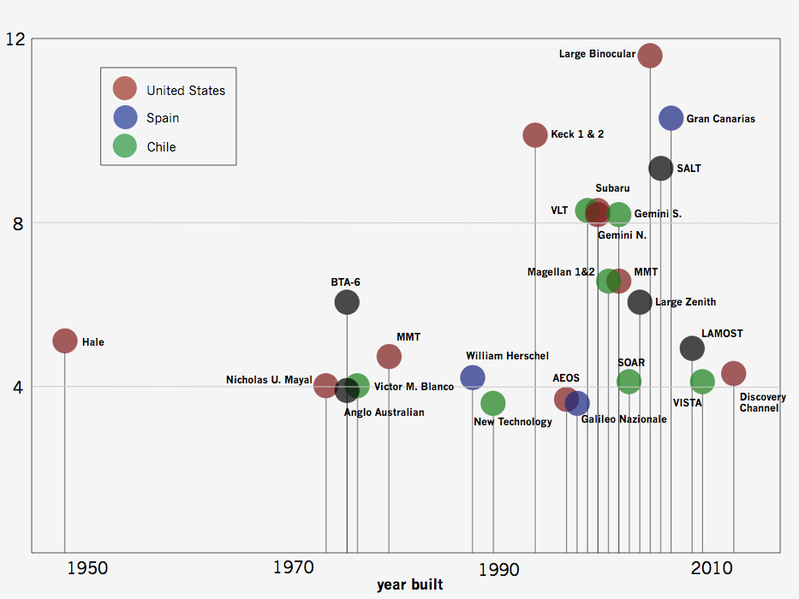 |
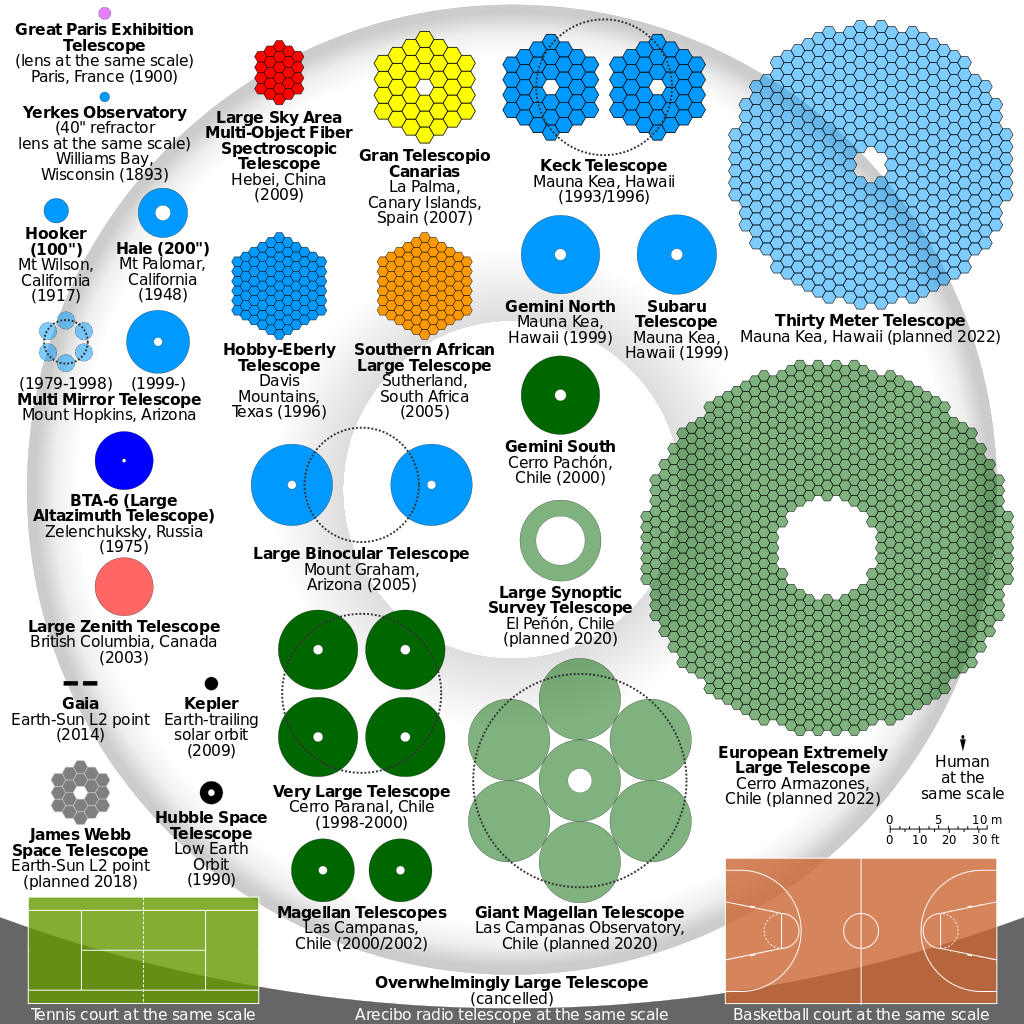 |
|---|---|
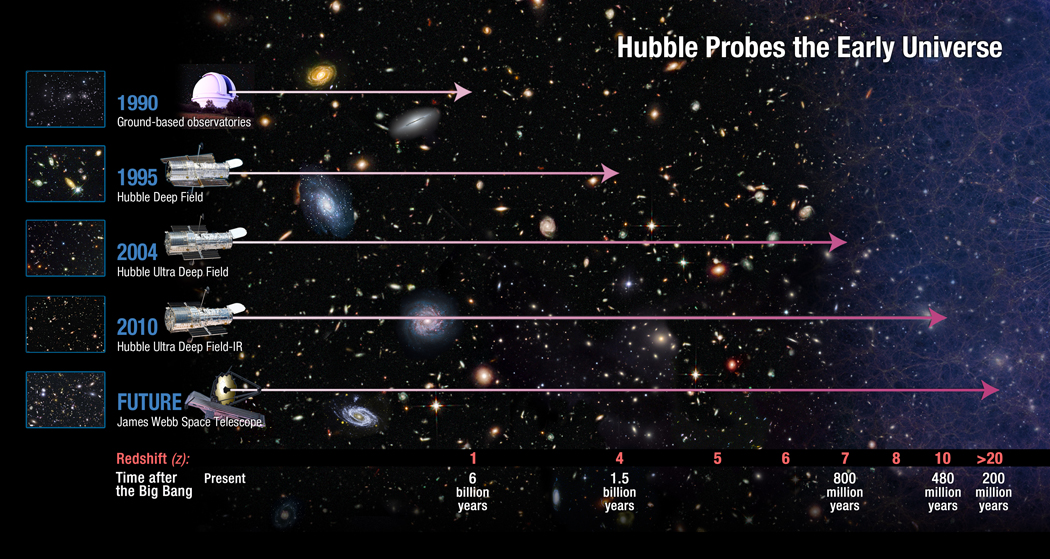 |
|---|
You can simulate diffraction using the "Waves" simulation at phet.colorado.edu.
W = Wavelength of the wave D = Size of the aperture A = Diffraction angle of the waveUsing the simulation, how would you construct a relationship between W, D, and A?
Limit of the human eye = Magnitude 7 Eye diameter = 5 mmIf you are looking at a magnitude 7 object, how many photons/second are you seeing?
How many arcseconds does Pluto move across the sky during a 10-hour observing session?
Suppose for an asteroid: Distance from Earth = 0.1 AU Speed transverse to Earth = 10 km/s Albedo = 0.2 Brightness = 24 magnitudesHow long does it take to move 1 arcsecond across the sky?
If we that assume the brightness of an object in the solar system is proportional to
Radius^2 * Albedo / (Distance from sun)^2 / (Distance from Earth)^2
What radius does the asteroid have to have to have magnitude 24? This sets the scale for the size of asteroids that Pan-STARRS can detect.
Suppose there exists a "Planet X" in the Kuiper belt with the following properties: Distance from sun = 60 AU Beyond the "Kuiper cliff" at 50 AU Albedo = .58 Same as Pluto Radius = 6371 km Same as EarthWhat is the brightness in magnitudes of this object?
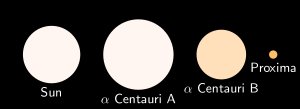 |
 |
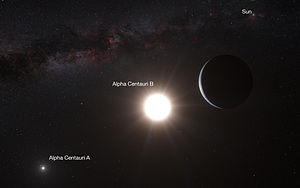 |
|---|---|---|
Mass Luminosity Temp Distance Magnitude Age Metallicity
(K) (ly) (Gyr) (dex)
Sun 1.00 1.00 5778 0.0 -27 4.57 0.0
Alpha Centauri A 1.10 1.52 5790 4.36 0.0 6 1.5
Alpha Centauri B .91 .50 5260 4.36 1.3 6 1.6
Alpha Centauri C .123 .0017 3042 4.24 11.0 4.85 .2 (Proxima Centauri)
Distance between Alpha Centauri A & B = 17.57 AU (semimajor axis)
Orbit time for Alpha Centauri A & B = 79.9 years
Distance from Alpha Centauri C to Alpha Centauri A & B = .21 light years
Suppose a hypothetical "Planet Z" orbits Alpha Centauri B such that
Distance from Alpha Centauri B = 1.0 AU
Distance from sun = 290000 AU = 4.36 light years
Radius = 1.0 Earth radii
Albedo = .37 Same as Earth
What is the magnitude of Planet Z as viewed from the Earth?
Suppose an extraterrestrial civilization is using transits to detect the Earth.
Earth orbit speed = 29.8 km/s Sun radius = 1.4e9 meters Time for the Earth to transit the sun = 46600 seconds = 12.9 hoursEarth surface area / Sun surface area = .000084
This is the fractional intensity drop when the Earth transits the sun.
Suppose a star like the sun has a planet with an orbital radius like the Earth's. Using data from the web, what is the minimum mass planet that Kepler can detect? What is the minimum mass planet that the redshift method can detect?
The Hipparcos and Gaia telescopes specialize in measuring precise star positions for parallaxes. For a star that is 100 light years away, how accurately can each of these telescopes measure their distance? How about for a star in Andromeda?
Suppose an asteroid is a distance of 0.1 AU from the Earth in the direction away from the sun (so that we're viewing it like a full moon). Suppose also that it has an albedo of 1. The smallest flux that Pan-STARRS can detect is 5e-18 Watts/meter^2. What is the smallest value for the radius of this asteroid that the Pan-STARRS telescope can detect?
Suppose an Earth-sized object is in the Kuiper belt and that it has an albedo of 1. What is the furthest distance from the sun that this object could be detected by the Pan-STARRS telescope?
Q = Radius of closest approach / Radius of Earth
Q Diameter Date
(meters)
Chelyabinsk 1.00 19 2013 2 15 .44 Megaton blast
Tunguska 1.0
1972 Fireball 1.0089 ~ 6 1972 Skimmed the upper atmosphere
2011-CQ1 1.87 1 2011 2 04
2008-TS26 1.96 1 2008 10 09
2011-MD 2.94 10 2011 6 27
2012-KT42 3.26 ~ 7 2004 5 29
2013-DA14 5.35 30 2013 2 15
2012-KP24 8.99 25 2004 5 28
2012-BX34 10.3 8 2012 1 27
2012-TC4 14.9 17 2012 10 12
2005-YU55 60.00 400 2005 11 8
http://en.wikipedia.org/wiki/List_of_asteroid_close_approaches_to_Earth
 |
|---|